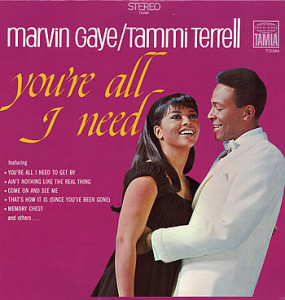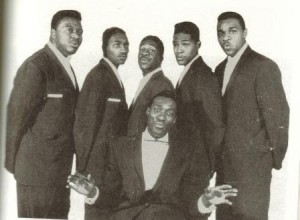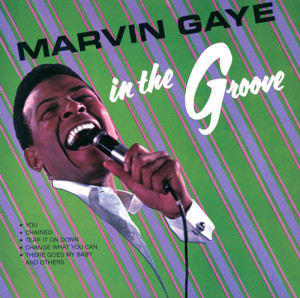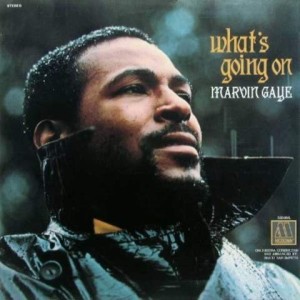
Marvin Gaye (April 2, 1939 – April 1, 1984), born Marvin Pentz Gay, Jr.  was an American singer songwriter and musician whose career spanned more than three decades. Born and raised in Washington, D.C. he was the son of a storefront minister of a local Pentecostal church sect and grew up singing gospel in church revivals as a young child.
was an American singer songwriter and musician whose career spanned more than three decades. Born and raised in Washington, D.C. he was the son of a storefront minister of a local Pentecostal church sect and grew up singing gospel in church revivals as a young child.
Gaye branched out into secular music as a teenager, joining the doo-wop group The Marquees, after returning from an honorable discharge from the United States Air Force, before the group was hired by Harvey Fuqua to be Harvey & the Moonglows. Following the band’s separation in 1960, Gaye began working as a session drummer for the Detroit music label Anna, before signing with Motown’s Tamla label in 1961, adding an “e” to his surname. Gaye was one of many who shaped the sound and success of Motown in the 1960′s, becoming the company’s top-selling solo artist of that decade with a string of hits, including “How Sweet It Is (To Be Loved By You)”, “Ain’t That Peculiar”, “I Heard It Through the Grapevine” and his duet singles with singers such as Mary Wells and Tammi Terrell.

Because of this, Gaye was given the titles “The Prince of Motown” and “The Prince of Soul”.
Following the death of Tammi Terrell in 1970, Gaye went into seclusion, emerging the following year with “What’s Going On” and its subsequent album, which helped to make him one of the first artists in Motown to break away from the reins of its production company to be his own artist. What’s Going On and its 1973 follow-up Let’s Get It On became among the first concept albums in R&B music. Gaye’s later music influenced the quiet storm, urban contemporary, slow jam and neo-soul music genres. After spending years as a European tax exile in the early 1980s, Gaye returned on the 1982 Grammy Award-winning hit, “Sexual Healing” and the Midnight Love album. After a violent argument with his father, he was shot dead by him on April 1, 1984, less than one day before his 45th birthday. Gaye was posthumously inducted to the Rock and Roll Hall of Fame in 1987. Gaye also ranked high on music magazines’ lists, ranking at number 18 on the 100 Greatest Artists of All Time on the American music magazine, Rolling Stone, and he ranked number 20 on VH-1′s list of the 100 Greatest Artists of All Time. Gaye, whose vocal range spanned three octaves, was subsequently ranked at number 6 on Rolling Stone’s list of the 100 Greatest Singers of All Time in 2008.
Life and career
Early life
 Marvin’s parents, Marvin Gay, Sr. and Alberta Cooper, married on July 2, 1935. The couple settled at southwest Washington, D.C. at 1617 First Street SW, only a few blocks from the Anacostia River. The Gay family called their First Street neighborhood “Simple City”, due to it being “half-city, half-country”. Marvin Gay had moved from Lexington, Kentucky to join a Pentecostal church sect known as the House of God, which had been based at Lexington where Gay joined as a child, where he ministered over a small church. The House of God took its teachings from Hebrew Pentecostalism, advocated strict conduct and adhered to both the Old and New Testaments. Two years after their marriage, their first child, Jeanne, was born in 1937. Their son, Marvin, Jr., was born two years after that, on April 2, 1939. The family eventually grew to include younger son Frankie and Zeola, named after her maternal aunt. Marvin had two other brothers from his parents’ relationships, Michael Cooper and Antwaun Carey Gay. Michael was sent by Gay, Sr. to live with Alberta’s sister, Pearl. Antwaun was from one of Gay, Sr.’s extra-marital affairs.
Marvin’s parents, Marvin Gay, Sr. and Alberta Cooper, married on July 2, 1935. The couple settled at southwest Washington, D.C. at 1617 First Street SW, only a few blocks from the Anacostia River. The Gay family called their First Street neighborhood “Simple City”, due to it being “half-city, half-country”. Marvin Gay had moved from Lexington, Kentucky to join a Pentecostal church sect known as the House of God, which had been based at Lexington where Gay joined as a child, where he ministered over a small church. The House of God took its teachings from Hebrew Pentecostalism, advocated strict conduct and adhered to both the Old and New Testaments. Two years after their marriage, their first child, Jeanne, was born in 1937. Their son, Marvin, Jr., was born two years after that, on April 2, 1939. The family eventually grew to include younger son Frankie and Zeola, named after her maternal aunt. Marvin had two other brothers from his parents’ relationships, Michael Cooper and Antwaun Carey Gay. Michael was sent by Gay, Sr. to live with Alberta’s sister, Pearl. Antwaun was from one of Gay, Sr.’s extra-marital affairs.
Marvin began singing at his father’s church and in church revivals starting around the age of five, with his first public performance being a version of “Journey to the Sky” at a Kentucky church revival with his father accompanying him on piano. His brother Frankie later recounted how Marvin’s public performance at a school play when he was 11 encouraged him to pursue a singing career. His early home life, his sister Jeanne Gay confided later, however, consisted of “brutal whippings” at the hands of his father, who struck him for any shortcoming. Marvin described living under his father’s house “was like living with a king, a very peculiar, changeable, cruel and all-powerful king.” He further stated “if it wasn’t for Mother, who was always there to console me and praise me for my singing, I think I would have been one of those child suicide cases you read about in the papers.” His sister Jeanne said Marvin was beaten often from age seven well into his teenage years. The four Gay children were frequent bed-wetters as children, which became the reason for more whippings. Marvin and his siblings would often be told to observe extended Sabbath, which started every Saturday, and to recite Biblical passages he taught them, striking them if they answered the passages wrong. By the late forties, Marvin’s father split from the House of God and joined the newly-formed House of the Living God, but later rejoined the original House of God and headed its Board of Apostles by the early fifties. Marvin Gay, Sr. eventually quit the House of God in the mid-fifties, after he wasn’t named Chief Apostle of the church. Marvin’s father never kept a job, working for a total of three years at the Western Union and the post office. He withdrew from social life after dropping out of the ministry, later developing alcoholism and spent his seclusion cross-dressing, wearing his wife’s clothes and wigs, which embarrassed his son. Marvin’s mother supported the family as a domestic worker. A rumor later emerged years after Gaye’s death that when he was fifteen, he was, alongside his older sister Jeanne, allegedly raped by his uncle Howard Gay. The rumor was posted on Michael Eric Dyson’s book, Mercy Mercy Me: The Art, Loves and Demons of Marvin Gaye but hasn’t been confirmed.
Marvin became a fan of secular music styles, including R&B and doo-wop. Before entering Cardozo High School and shortly after the Gay family relocated to D.C.’s Deanwood neighborhood in northeastern Washington, he had joined several doo-wop groups in the D.C. area, including the Dippers, which featured his friend Johnny Stewart, brother of R&B singer Billy Stewart. He also sang with another future Motown vocalist, Bobby Taylor, and later joined the D.C. Tones, in which he played drums and included another close friend Reese Palmer, and Sondra Lattisaw, mother of R&B singer Stacy Lattisaw. During his teen years, the younger Marvin’s relationship with his father further deteriorated and he often was kicked out of the house by his father for what he perceived was misbehavior, later leaving the house for good after standing up to his father during an argument. Fancying himself a flyer, Marvin, at seventeen, decided to enlist in the United States Air Force as a Basic Airman. Disappointed in having to do menial tasks, such as peeling potatoes, he rebelled against the orders. Faking mental illness, he was discharged. His sergeant stated that Marvin refused to follow orders.
Early recordings and initial success
 Following the move to Tamla, Marvin initially settled on session work, playing drums on earlier Tamla recordings for The Marvelettes, The Miracles and Little Stevie Wonder. According to David Ritz, Marvin was teased about his surname, with some people asking jokingly, “Is Marvin Gay?”. Eventually he and Motown added an “e” to his surname prior to the release of his first single and album. The move was to silent rumors of his sexuality and to add further distancing from his father and his namesake.
Following the move to Tamla, Marvin initially settled on session work, playing drums on earlier Tamla recordings for The Marvelettes, The Miracles and Little Stevie Wonder. According to David Ritz, Marvin was teased about his surname, with some people asking jokingly, “Is Marvin Gay?”. Eventually he and Motown added an “e” to his surname prior to the release of his first single and album. The move was to silent rumors of his sexuality and to add further distancing from his father and his namesake.
Having been inspired by singers such as Nat King Cole, Ray Charles and Frank Sinatra, Gaye wanted to perform standards, figuring the move would make him a crossover success, rather than perform the usual R&B performed on Motown, bringing him to conflict with the label. Gaye’s first album, The Soulful Moods of Marvin Gaye, released in June 1961, failed to chart, however. Gaye’s first single, “Let Your Conscience Be Your Guide”, found regional success but also failed to chart, as would two more of Gaye’s recordings by 1962. Gaye had aspired to be a Perry Como-styled performer that did not have to resort to “shaking ass onstage”, rather, just sit on a stool and croon. Following these failures, Gaye spent most of the rest of 1961 being paid $5 (US$39 in 2013 dollars) a week playing drums for the Miracles and blues artist Jimmy Reed. While Gaye refused to attend grooming school courses at the John Roberts Powers School for Social Grace in downtown Detroit due to his unwillingness to comply with its orders, he took advice from Maxine Powell on keeping his eyes open rather than closed while he sung because, Powell told him, “it looks like you’re sleeping when you’re performing”. Gaye drummed on The Marvelettes’ “Please Mr. Postman” and several of their other recordings, including “Beechwood 4-5789″, which Gaye co-wrote. He also played drums on Little Stevie Wonder’s original instrumental of “Fingertips”, and later played on the popular live version of the song.
Later in 1962, Gaye released his first charted hit, “Stubborn Kind of Fellow”, which peaked in the low top 50 of the Billboard Hot 100 and reached the top ten on the R&B side. Gaye’s first top 40 pop song, “Hitch Hike”, was soon followed by his first top ten hit single, “Pride & Joy”. Other hit singles during this period included “Can I Get a Witness”, “You Are a Wonderful One” and “Try It Baby”. In 1964, he scored his first hit duets with singer Mary Wells including “Once Upon a Time”, which was later featured on the duo’s album, Together, which became Gaye’s first charted album. That same year, he played drums, provided background vocals and composition to Martha and the Vandellas’ “Dancing in the Street”. Gaye’s success grew the following year after three of his singles, “How Sweet It Is (To Be Loved By You)”, “I’ll Be Doggone” and “Ain’t That Peculiar”, reached the top ten and sold a million copies each. Gaye notched his next duet success late the following year with Kim Weston, on the song, “It Takes Two”.
Success with Tammi Terrell and I Heard It Through the Grapevine
 In 1967, Gaye began working on duets with singer Tammi Terrell. The duo’s hits included “Ain’t No Mountain High Enough”, “Your Precious Love”, “Ain’t Nothing Like the Real Thing” and “You’re All I Need to Get By”. Most of their hit recordings were composed by Nickolas Ashford and Valerie Simpson. Despite the romantic tension in their recordings, Gaye and Terrell’s relationship was platonic. In October of the year, Terrell collapsed in Gaye’s arms during a performance together in Farmville, Virginia. Gaye held her and sent her backstage where she was rushed to Farmville’s Southside Community Hospital. Doctors there discovered that Terrell had a tumor in her brain.
In 1967, Gaye began working on duets with singer Tammi Terrell. The duo’s hits included “Ain’t No Mountain High Enough”, “Your Precious Love”, “Ain’t Nothing Like the Real Thing” and “You’re All I Need to Get By”. Most of their hit recordings were composed by Nickolas Ashford and Valerie Simpson. Despite the romantic tension in their recordings, Gaye and Terrell’s relationship was platonic. In October of the year, Terrell collapsed in Gaye’s arms during a performance together in Farmville, Virginia. Gaye held her and sent her backstage where she was rushed to Farmville’s Southside Community Hospital. Doctors there discovered that Terrell had a tumor in her brain.
The cancer ended Terrell’s career as a live performer though she continued to record music under careful supervision. Terrell’s illness later led to problems with continuing to record following her repeated operations to remove the tumor. Gaye was reportedly devastated by Terrell’s sickness and became disillusioned about the record business. In October 1968, Gaye’s recording of “I Heard It Through the Grapevine” was released and became Gaye’s first to reach number one on the Billboard Hot 100 and also reached the top of the charts in other countries, selling well over a million copies. However, Gaye felt the success was something he “didn’t deserve” and that he “felt like a puppet — Berry’s puppet, Anna’s puppet…”[54][55][56] Gaye followed it with songs such as “Too Busy Thinking About My Baby” and “That’s the Way Love Is”, which reached the top-ten on the Billboard Hot 100 in 1969. That year, his album, M.P.G., became his first top-40 pop album as well as his first number-one R&B album. Gaye, who was one of the few Motown artists to write his own material, produced and co-wrote two hits for The Originals including “Baby I’m For Real” and “The Bells”.
On March 16, 1970, Tammi Terrell succumbed from brain cancer. Gaye, who wept openly at her funeral, responded to her death by going into a prolonged seclusion from the music business. After a period of depression, Gaye sought out a position on a professional football team, the Detroit Lions, where he later befriended Mel Farr and Lem Barney. It was eventually decided that Gaye wouldn’t be allowed to try out due to fears of possible injuries that could’ve affected his music career.
What’s Going On and subsequent success
On June 10, 1970, Gaye returned to the Hitsville U.S.A.studios where he recorded his new  composition, “What’s Going On”, inspired by an idea from Renaldo “Obie” Benson of the Four Tops after he witnessed an act of police brutality at an anti-war rally in Berkeley. Gaye later played the song to Berry Gordy, who refused to release it due mainly to its jazz-oriented sound, which Gordy labeled “outdated” and thought the song was “too political” for radio at the time. Gaye refused to record unless Motown released the song. The song was eventually released on January 17, 1971 and quickly shot to number-one on the R&B charts within a month staying there for five weeks, also reaching number-two on the Billboard pop chart and the Record World chart, and number-one on Cashbox’s pop chart for a week, selling over two million copies.
composition, “What’s Going On”, inspired by an idea from Renaldo “Obie” Benson of the Four Tops after he witnessed an act of police brutality at an anti-war rally in Berkeley. Gaye later played the song to Berry Gordy, who refused to release it due mainly to its jazz-oriented sound, which Gordy labeled “outdated” and thought the song was “too political” for radio at the time. Gaye refused to record unless Motown released the song. The song was eventually released on January 17, 1971 and quickly shot to number-one on the R&B charts within a month staying there for five weeks, also reaching number-two on the Billboard pop chart and the Record World chart, and number-one on Cashbox’s pop chart for a week, selling over two million copies.
Emboldened by its success, Gaye spent ten days recording the What’s Going On album after Gordy gave him an ultimatum of completing the album by the end of that March. Though the album’s subject matter again led to Gordy advising to Gaye of its potential of damaging his core fan base, Motown issued the album that May after Gaye remixed the album in Hollywood. The album became Gaye’s first million-selling album and featured two more top-ten hits, “Mercy Mercy Me (The Ecology)” and “Inner City Blues”. The album became one of Motown’s first autonomous works, without the help of Motown’s staff producers. Its themes and segue flow brought the concept album format to rhythm and blues music. The album was later hailed as “the most important and passionate record to come out of soul music, delivered by one of its finest voices”. Gaye won several music industry awards following the album’s success including Billboard’s Trendsetter of the Year while Rolling Stone named it the “Album of the Year”. He won several NAACP Image Awards including Producer of the Year and Male Vocalist of the Year while the album won Album of the Year. The “What’s Going On” song was nominated for two Grammy Awards including Best Male R&B Vocal Performance. Following a couple of performances, one at the Kennedy Center in his native Washington, and for a non-profit organization dedicated to end the plight of urban poverty, Gaye signed a $1 million (US$5,556,086 in 2013 dollars) new deal with Motown, making it the most lucrative deal by a black recording artist at the time. Gaye first responded to the new contract with the soundtrack and subsequent score, Trouble Man, released in late 1972.
From Wikipedia, the free encyclopedia



